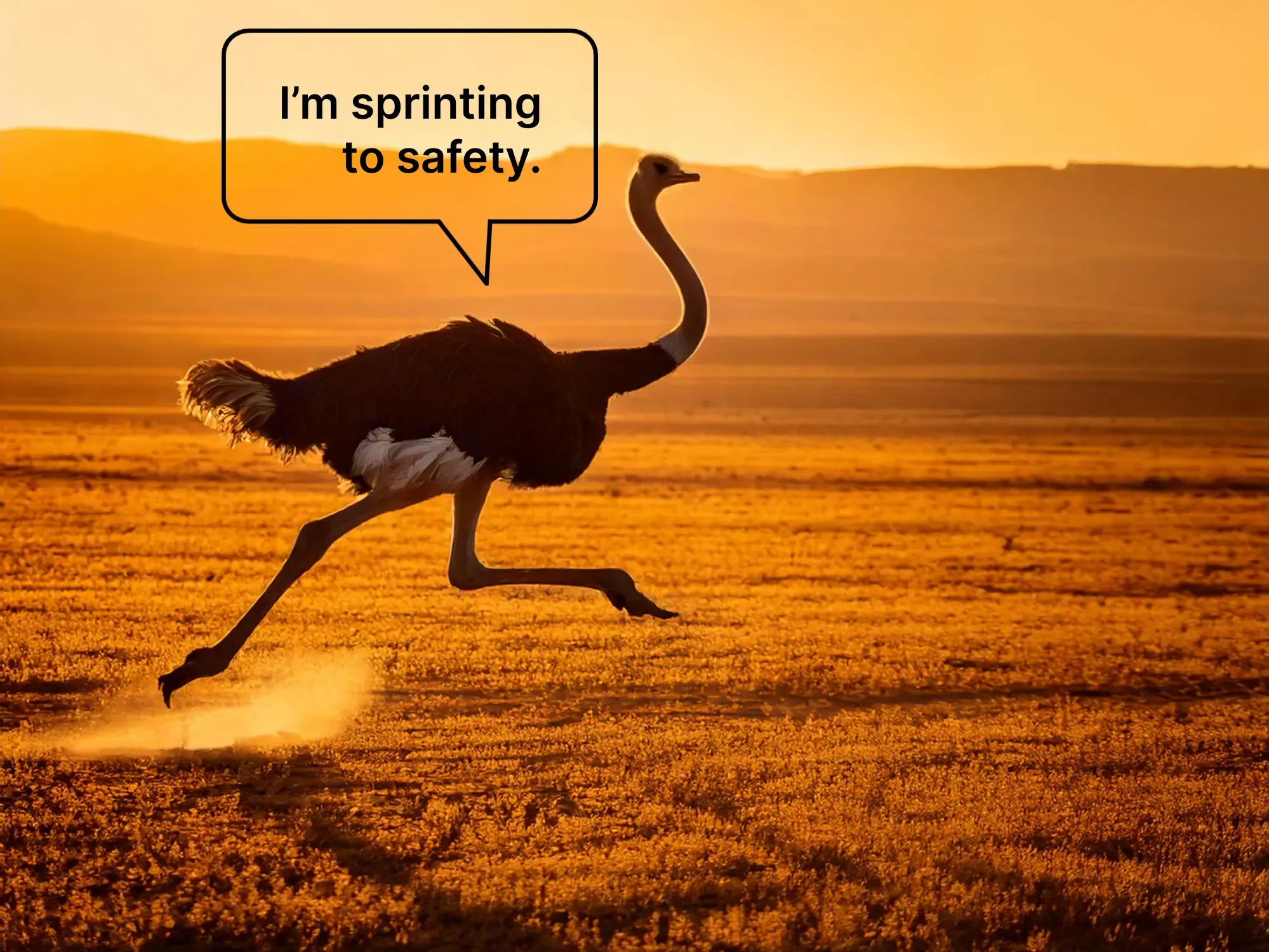Break Free from the Ostrich Effect to Quit Smoking for Good
Discover why it happens, how it works, and proven strategies to overcome it.
Daniel Stefan
Dec 26, 2024
7 min read

Have you ever heard the expression “burying your head in the sand like an ostrich”? It’s a metaphor often used to describe ignoring danger or reality, hoping it will simply disappear. Though ostriches don’t actually bury their heads in the sand, the phrase paints a vivid picture: an ostrich, facing a predator like a lion, hides its head, making itself an even easier target.
This expression is often used to criticize those who choose to ignore uncomfortable truths. Why? Because pretending a problem doesn’t exist doesn’t make it go away—it just leaves you more vulnerable. When it comes to smoking, this tendency to avoid confronting reality can be described as the “Ostrich Effect.”
I know this firsthand. Thirteen years ago, I was battling to quit smoking, and I was deeply entrenched in the Ostrich Effect. Until I faced the truth, I couldn’t break free. Let’s explore how this effect works in the context of smoking and, more importantly, how you can overcome it to quit for good.
The Ostrich Effect is rooted in the psychological concept of cognitive dissonance. Introduced by Leon Festinger in 1957, cognitive dissonance describes the mental discomfort people feel when they hold two contradictory beliefs or when their actions conflict with their values. Smokers often embody this conflict: they understand the dangers of smoking but continue the habit. To ease this discomfort, they downplay the risks (“It won’t happen to me”) or avoid confronting the truth entirely (“I don’t want to see the consequences”).
Take my friend Alan as an example. When I tried to discuss the risks of smoking with him, he said, “Daniel, I don’t even want to hear about that. If I see something like that or if you tell me about it, I’ll probably get sick just from seeing it. It’s better not to look at it at all.” Alan’s reaction was a textbook example of the Ostrich Effect—ignoring danger to preserve temporary comfort.

This phenomenon isn’t unique to smokers. It’s pervasive in many areas of life. A 2009 study, The Ostrich Effect: Selective Attention to Information about Investments (3), found that investors are less likely to check their portfolios during falling markets. Instead of seeking solutions, they avoid confronting bad news to escape discomfort. Similarly, smokers avoid anti-smoking campaigns, warnings on cigarette packs, or even documentaries that highlight the consequences of their habit.
Ultimately, people ignore the risks of smoking or rationalize their behavior because facing reality feels too overwhelming. But this avoidance only strengthens the habit, making it harder to quit.
While ostriches, in reality, either flee or stay low to avoid predators, people often do the opposite. By metaphorically burying their heads in the sand, they expose themselves to dangers they’d prefer to avoid. Smokers who give in to the Ostrich Effect are heading toward the same inevitable outcomes: disease, disability, and premature death. It’s not a matter of if the predator will catch them but when.
On average, smokers live 10 to 15 years less than non-smokers (2). Worse yet, smoking is responsible for about 30% of all cancer deaths in the United States (3). Some may dismiss this with, “I’ll die anyway,” but that’s only part of the story. Many smokers who don’t die early face life-altering consequences instead. Some lose limbs to conditions like Buerger’s disease, while others lose their ability to see, speak, move, or even breathe freely.
Buerger’s disease, almost entirely caused by smoking (4), restricts blood flow, leading to gangrene and amputation. For those who experience it, the phrase “I’ll die anyway” quickly loses its bravado. The harsh reality of living with such debilitating conditions is often far worse than an earlier death.
The question isn’t just whether you’ll face these consequences but whether you’ll continue heading toward them. You have the power to change course—to confront the danger and sprint toward safety before it’s too late.
For over a decade, I was stuck in the Ostrich Effect. I avoided pictures of diseased lungs, skipped anti-smoking campaigns, and ignored any information that might force me to confront the reality of my habit. It wasn’t until I found the courage to face the truth that I could finally break free.
My turning point came 13 years ago when I watched a YouTube video of Dan, a man battling Buerger’s disease. His story was harrowing. The pain and suffering he endured left an indelible mark on me. I remember thinking, This will not happen on my shift. From that moment, I vowed to do everything in my power to quit smoking. No cigarette could ever justify such unimaginable pain.
Dan’s courage saved my life. Though he has since passed away, his testimonial remains a powerful wake-up call. Watching his story didn’t amplify my fear—it shattered my denial. Confronting the harsh realities of smoking was painful, but it was also liberating. It gave me the resolve to quit and reclaim my health.
Real-life testimonials work. One of my wife’s best friends, Maria, had been smoking for over a decade and felt trapped. She told my wife she wanted to quit but didn’t believe she could. Hearing this, I suggested something simple: "Tell Maria to search for testimonials about the effects of smoking on YouTube. After watching those, she’ll be like Schwarzenegger’s Terminator—unstoppable in her fight against smoking." A week after following that advice, Maria quit cold turkey. Within two weeks, she was free from cigarettes, and she’s been a non-smoker for years now.

If you’re also struggling with the Ostrich Effect, here’s how you can overcome it:
1. Craft a Two-Week Action Plan
Commit to a simple yet effective plan: for the next two weeks, make a checklist to ensure you watch 2–3 testimonials each day about the devastating effects of smoking. The key is consistency—spreading it out daily instead of consuming them all at once. This builds a steady and impactful habit of facing reality without feeling overwhelmed.
2. Watch Testimonials and Break the Cycle of Denial
It’s time to confront the uncomfortable truth. Search YouTube for testimonials from people who have suffered severe consequences from smoking. These heartfelt stories might be difficult to watch, but they’re a vital step toward breaking free from the Ostrich Effect. By witnessing their struggles, you’ll gain the courage to face your own fears and take action.
3. Learn from Doctors and Surgeons
Dive into educational content from medical professionals who discuss the health risks of smoking. Some of the most eye-opening moments come from watching real surgeons handle the aftermath of smoking—such as removing damaged lung tissue. Seeing this visual evidence can be shocking, but it reinforces the urgency to quit and strengthens your resolve.
4. Stay Persistent: Fall Nine Times, Rise Ten
Relapses happen, but they don’t define you. Remember the story of those who gave up just before striking gold—it’s the same with quitting smoking. If you slip up and pick up a cigarette again, don’t let it derail your journey. Revisit the testimonials, listen to the experts, and get back on track. Each attempt brings you closer to your goal of becoming smoke-free for good.
Confronting the truth about smoking isn’t easy, but it’s the first step toward freedom. By overcoming the Ostrich Effect, you’ll not only improve your health but also reclaim years of your life that might otherwise be lost. You’ll breathe easier, feel stronger, and set an example for others who may be struggling with the same habit.
Quitting smoking isn’t just about avoiding disease or death—it’s about embracing life. It’s about waking up every day without the shadow of addiction looming over you. It’s about sprinting toward a future where you’re in control, not the cigarettes.
If you’re ready to break free from the Ostrich Effect, take the first step today. Confront the truth, face your fears, and start your journey to a healthier, smoke-free life. As someone who’s been in your shoes, I can tell you this: the effort is worth it. The freedom is worth it. And most importantly, you are worth it.
Studies:
(1) The 'Ostrich Effect': Selective Attention to Information about Investments Findings: This study investigates how investors monitor their investment portfolios in response to market fluctuations. The researchers found that investors are more likely to check the value of their portfolios during rising markets and less likely during falling markets. This behavior suggests that investors tend to avoid exposure to negative information—a phenomenon termed the "Ostrich Effect." By selectively seeking information that confirms positive outcomes and avoiding negative data, investors may experience short-term psychological comfort but potentially at the cost of making less informed financial decisions. Karlsson, N., Loewenstein, G., & Seppi, D. (2009). The 'Ostrich Effect': Selective Attention to Information about Investments. Journal of Risk and Uncertainty, 38(2), 95-115. DOI:10.1007/s11166-009-9060-6
(2) Cigarette Smoking and Life Expectancy in the United States Findings: This study published by the Centers for Disease Control and Prevention (CDC) found that smoking significantly reduces life expectancy by 10-15 years compared to non-smokers. CDC (2020) National Center for Health Statistics. CDC Website
(3) Tobacco Use and Cancer: A Global Perspective Findings: This study by the American Cancer Society highlights that smoking is responsible for approximately 30% of all cancer deaths in the U.S., particularly lung, throat, and mouth cancers. American Cancer Society. (2020). Tobacco Use and Cancer: A Global Perspective. Available at American Cancer Society Website
(4) Buerger's Disease: A Review of Pathogenesis and Diagnosis Findings: This study discusses Buerger's disease (thromboangiitis obliterans), a disease caused almost entirely by smoking. It leads to blood vessel inflammation, potentially resulting in loss of limbs and severe health consequences. Alomari, M. A., & Juma, M. A. (2015). Buerger's Disease: A Review of Pathogenesis and Diagnosis. Journal of Vascular Surgery, 61(2), 465-472. PubMed